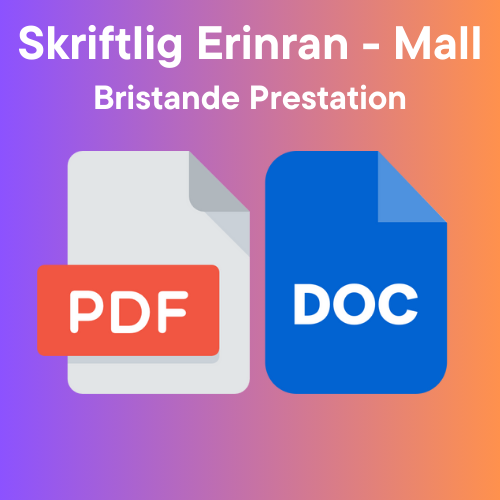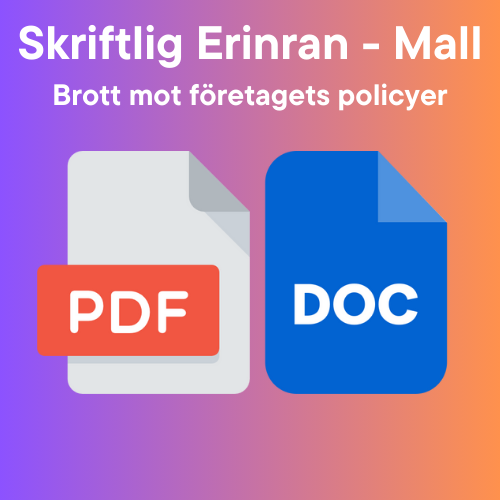What should an Erinran contain?
Share
Introduction
A reprimand is a formal document used by employers to point out and document an employee's misconduct or underperformance in the workplace. It is an important part of the employer's toolbox for dealing with problems in the workplace in a structured and legal manner. In this article we will go through what a reminder should contain, why it is important and how to design it to be as effective as possible.
What is a memory?
A reminder is a written notice that the employer issues to an employee when he is deemed to have violated the company's rules, policies or performed below expectations. The purpose of a reminder is to give the employee an opportunity to improve before more drastic measures, such as dismissal, are considered.
It is important not to confuse a reminder with a warning, even though these two concepts are often used synonymously in everyday speech. A reminder is a first step in a process where the employer addresses a problem, while a warning is often a more serious step that can precede a dismissal.
When should a reminder be issued?
A reminder should be issued when the employer observes a pattern of unacceptable behavior or underperformance that is not addressed despite previous reprimands. Common reasons for issuing a recall may include:
- Repeated late arrivals or absences without a valid reason.
- Mismanagement of duties or low work ethic.
- Violation of company policy or guidelines.
- Unacceptable behavior towards colleagues or customers.
It is important that the reminder is issued as soon as possible after the problem is discovered to ensure that it is relevant and that the employee is given a chance to correct their behaviour.
What should a memorial contain?
A well-written memorial should include the following elements:
-
Introduction:
Here, the employer must clearly state the purpose of the reminder and that it is a formal notification. The date of when the recall is issued should also be included.
-
Description of the problem:
A detailed description of the behavior or performance that does not meet the employer's expectations. Specify the dates and times when the events in question occurred. If there are witnesses or other documentation that supports the employer's claim, this should also be mentioned.
-
Consequences of the behavior:
Describe what consequences the current behavior or performance has had on the workplace, colleagues or company operations. Explain why this behavior is not acceptable and how it is against company policy or guidelines.
-
Expectations and requirements:
Clarify what changes the employer expects from the employee. Specify a time frame within which improvements must occur. Inform that further action, such as a warning or termination, may be taken if the behavior does not improve.
-
Possibility of explanation:
Give the employee an opportunity to give his version of events and explain his behavior. Encourage the employee to come up with any suggestions on how the situation can be improved.
-
Closing and signature:
Conclude the reminder with a clear call for the employee to absorb the information and improve their behavior. The reminder should be signed by both the employer and the employee. It is important that the employee receives a copy of the document and that the original is archived.
How do you formulate a reminder?
The wording of a memorial should be factual, clear and free from emotional expressions. Language should be professional and respectful, even if the recall itself is about a serious problem.
Example of wording:
"On August 15, 2024, it was noted that you again arrived late to work without giving advance notice of your absence. This is the third time in two weeks that this has happened, and it is negatively affecting our team's work. We expect you to arrive in future time and notify any absence in advance as per company policy. If this situation does not improve within the next month, we will need to consider further action."
Why is it important to issue a reminder?
Issuing a reminder has several important functions:
-
Documentation:
The reminder serves as proof that the employer has informed the employee of the problem and given him the opportunity to improve. This is important should the situation escalate and lead to a legal dispute.
-
Clarity:
A reminder makes it clear to the employee exactly what is wrong and what the expectations are for improvements. This minimizes the risk of misunderstandings and creates a structure for how the situation should be handled.
-
Prevention:
By issuing a reminder at an early stage, the employer can often prevent a minor problem from growing into something bigger and more serious. It gives the employee a chance to correct their behavior before further action is needed.
What happens if the employee does not improve?
If the employee shows no improvement after receiving a reminder, the employer may need to consider further action. This may include issuing a formal warning, reassignment or in some cases dismissal. It is important that the employer acts in accordance with applicable labor law rules and that all measures taken are well documented.
Common mistakes when issuing reminders
When issuing a recall, it is important to avoid some common mistakes:
-
Ambiguity:
If the reminder does not clearly specify what the problem is and what the expectations are of the employee, it can lead to confusion and misunderstanding.
-
Delay:
Waiting too long to issue a reminder can make it less effective and can signal that the employer is not taking the problem seriously.
-
Lack of documentation:
If the recall is not well documented, it may be difficult to use it as evidence if the situation escalates into a legal dispute.
-
Focusing on person instead of behavior:
It is important that the reminder focuses on the unwanted behavior and not on the employee as a person. This reduces the risk of the employee feeling personally attacked and defending himself instead of working on improvements.
Summary
A reminder is an important tool for employers when dealing with problematic behavior or underperformance in the workplace. For a reminder to be effective, it should be clear, factual and well structured. It should give the employee a clear picture of what is expected and what can happen if improvements do not take place. By following the guidelines presented in this article, employers can ensure that their recall is legally secure and effective in creating a better work environment.




